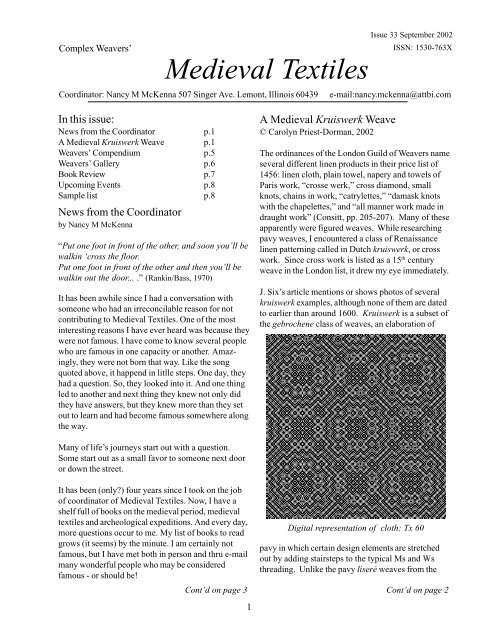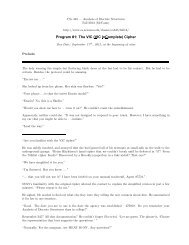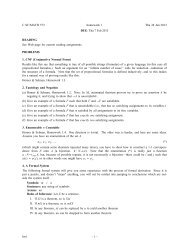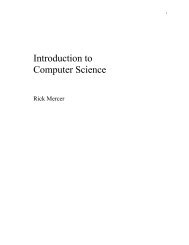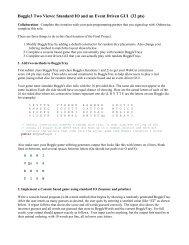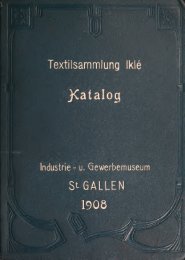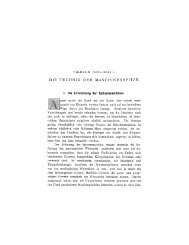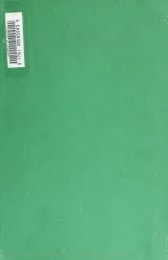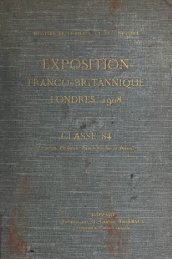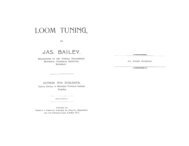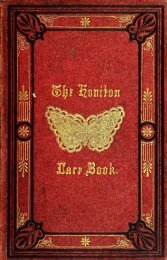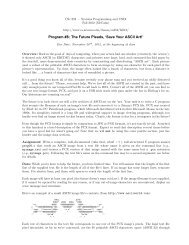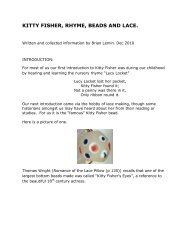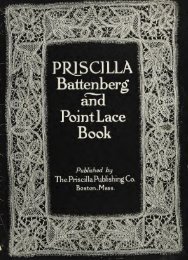Medieval Textiles
Medieval Textiles
Medieval Textiles
Create successful ePaper yourself
Turn your PDF publications into a flip-book with our unique Google optimized e-Paper software.
Complex Weavers’<br />
<strong>Medieval</strong> <strong>Textiles</strong><br />
Issue 33 September 2002<br />
ISSN: 1530-763X<br />
Coordinator: Nancy M McKenna 507 Singer Ave. Lemont, Illinois 60439 e-mail:nancy.mckenna@attbi.com<br />
In this issue:<br />
News from the Coordinator p.1<br />
A <strong>Medieval</strong> Kruiswerk Weave p.1<br />
Weavers’ Compendium p.5<br />
Weavers’ Gallery p.6<br />
Book Review p.7<br />
Upcoming Events p.8<br />
Sample list p.8<br />
News from the Coordinator<br />
by Nancy M McKenna<br />
“Put one foot in front of the other, and soon you’ll be<br />
walkin ‘cross the floor.<br />
Put one foot in front of the other and then you’ll be<br />
walkin out the door... .” (Rankin/Bass, 1970)<br />
It has been awhile since I had a conversation with<br />
someone who had an irreconcilable reason for not<br />
contributing to <strong>Medieval</strong> <strong>Textiles</strong>. One of the most<br />
interesting reasons I have ever heard was because they<br />
were not famous. I have come to know several people<br />
who are famous in one capacity or another. Amazingly,<br />
they were not born that way. Like the song<br />
quoted above, it happend in litlle steps. One day, they<br />
had a question. So, they looked into it. And one thing<br />
led to another and next thing they knew not only did<br />
they have answers, but they knew more than they set<br />
out to learn and had become famous somewhere along<br />
the way.<br />
A <strong>Medieval</strong> Kruiswerk Weave<br />
© Carolyn Priest-Dorman, 2002<br />
The ordinances of the London Guild of Weavers name<br />
several different linen products in their price list of<br />
1456: linen cloth, plain towel, napery and towels of<br />
Paris work, “crosse werk,” cross diamond, small<br />
knots, chains in work, “catrylettes,” “damask knots<br />
with the chapelettes,” and “all manner work made in<br />
draught work” (Consitt, pp. 205-207). Many of these<br />
apparently were figured weaves. While researching<br />
pavy weaves, I encountered a class of Renaissance<br />
linen patterning called in Dutch kruiswerk, or cross<br />
work. Since cross work is listed as a 15 th century<br />
weave in the London list, it drew my eye immediately.<br />
J. Six’s article mentions or shows photos of several<br />
kruiswerk examples, although none of them are dated<br />
to earlier than around 1600. Kruiswerk is a subset of<br />
the gebrochene class of weaves, an elaboration of<br />
Many of life’s journeys start out with a question.<br />
Some start out as a small favor to someone next door<br />
or down the street.<br />
It has been (only?) four years since I took on the job<br />
of coordinator of <strong>Medieval</strong> <strong>Textiles</strong>. Now, I have a<br />
shelf full of books on the medieval period, medieval<br />
textiles and archeological expeditions. And every day,<br />
more questions occur to me. My list of books to read<br />
grows (it seems) by the minute. I am certainly not<br />
famous, but I have met both in person and thru e-mail<br />
many wonderful people who may be considered<br />
famous - or should be!<br />
Cont’d on page 3 Cont’d on page 2<br />
1<br />
Digital representation of cloth: Tx 60<br />
pavy in which certain design elements are stretched<br />
out by adding stairsteps to the typical Ms and Ws<br />
threading. Unlike the pavy liseré weaves from the
Complex Weavers’ <strong>Medieval</strong> Textile Study Group<br />
“Kruiswerk” Sint-Truiden Tx 60 drafted by Carolyn Priest-Dorman.<br />
Trompe as writ; this draft does not show the entire treadling repeat<br />
last article, they have twill floats of varying length in<br />
both systems on both faces of the textile. The historic<br />
examples all require more than four shafts to weave.<br />
None of the 17 th and 18 th century gebrochene variants<br />
in Zeigler or Lumscher look quite like kruiswerk; most<br />
of them are closer to pavy in style. Marjie Thompson<br />
published the draft of an early 17 th century kruiswerk,<br />
the “Earl of Mar canvas,” in 1997. However, late last<br />
spring I encountered an even earlier example, a textile<br />
dating to around the 15 th century, Tx 60, documented<br />
among the holdings of the Abbey of St. Truiden in<br />
Belgium. It is in the same pattern family as Six’s<br />
kruiswerk examples and the Earl of Mar piece.<br />
Here is a draft of Tx 60 from St. Truiden. Daniël de<br />
Jonghe analyzed the weave and produced a draft<br />
which I have simply redrafted into a more standardized<br />
American notation. This particular kruiswerk is<br />
woven on 12 shafts. Unlike the Earl of Mar piece, its<br />
twill floats are balanced by an expanse of tabby<br />
ground. The original textile remnant is a complete<br />
loomwidth of between 64 and 65.8 cm in width and<br />
21.5 cm in length. It is woven of linen, possibly<br />
bleached, at 23 warps and 17 wefts per centimeter.<br />
Each selvedge is reinforced with a single S-plied<br />
thread (Stof uit de Kist, pp. 268-270).<br />
It is not clear to me yet where Six got the term<br />
kruiswerk, but his article suggests there’s an early<br />
manuscript with drafts of this type of weave structure.<br />
2<br />
I am looking into this more deeply, as it would be so<br />
nice to be able to identify kruiswerk as the “cross<br />
work” of the London regulations.<br />
Sources:<br />
Consitt, Frances. The London Weavers’ Company<br />
from the Twelfth Century to the Close of the Sixteenth<br />
Century. Oxford: Clarendon Press, 1933.<br />
Hilts, Patricia. The Weavers Art Revealed. Facsimile,<br />
Translation, and Study of the First Two<br />
Published Books on Weaving: Marx Zeigler’s “Weber<br />
Kunst und Bild Buch” (1677) and Nathaniel<br />
Lumscher’s “Neu eingerichtetes Weber Kunst und<br />
Bild Buch” (1708). Ars Textrina, vols. 13-14 (December<br />
1990).<br />
Six, J. “Kruiswerk, Lavendel, Pavy en Pellen,” Het<br />
Huis, Oud & Nieuw, vol. 10 (1912), pp. 105-122.<br />
Stof uit de Kist: De middeleeuwse textielschat uit de<br />
abdij van Sint-Truiden. Provinciaal Museum voor<br />
Religieuze Kunst, Begijnhofkerk, Sint-Truiden.<br />
Leuven: Uitgeverij Peeters, 1991. (Textile analysis<br />
and catalogue entry by Daniël de Jonghe.)<br />
Thompson, Marjie. “The Earl’s Canvas,” Weaver’s,<br />
Issue 38 (Winter 1997), pp. 38-40.
News from the Coordinator, Cont’d<br />
But the festivities this summer season no doubt took<br />
you out the door - and to see some wonderful and<br />
amazing things. Don’t let your knowledge languish!<br />
Share it.<br />
Oh, and you’re doing great! Keep going...<br />
Some News:<br />
Shoud of Turin:<br />
According to news appearing in various outlets this<br />
summer, Mechthild Fleury-Lemburg of Bern, Switzerland<br />
is doing restoration of the Shroud of Turin.<br />
Cardinal Severino Poletto, the archbishop of Turin<br />
and the shroud’s custodian, said in an interview with<br />
the Italian Catholic newspaper L’Avvenire that the<br />
Vatican approved the tests. Although many have<br />
suggested this newsletter cover this important cloth, I<br />
have not done so because:<br />
Firstly, testing seems to indicate the cloth is from the<br />
first century AD, but not everyone agrees. This is<br />
based upon conflicting carbon dating of the linen<br />
fibers & the fact that they are handspun, while after<br />
1200 linen in Europe was most often wheel-spun<br />
(Meacham, 1983). Although some carbon dating<br />
shows it to be of first century origins, others have put<br />
the date much later. Samples used for dating have<br />
been shown to contain gum arabic and starch from<br />
repairs to the cloth done in the last 600 years. So it<br />
comes as no surprise that the dating is variable. Pollen<br />
analysis shows that of 58 types of pollen found in the<br />
cloth, 41 are indigenous to only the Dead Sea. The<br />
statistics are: cloth is 3-1/2’ x 14-1/2’ (1.1m x 4.3m;<br />
2 x 8 cubits) woven of linen in a 3/1 herringbone twill<br />
(Raes, 1976) and it has been suggested that the cloth<br />
is of Syrian origins. So, the date-testing so far is<br />
contradictory and problematic and as of yet there is<br />
no real consensus on the results with 2 major opinions<br />
emerging: one for the 1st century and the other for a<br />
medieval date. Images of the shroud appear in manuscripts<br />
as early as 1192 (Pray Manuscript)<br />
Secondly, & possibly more importantly, the suggestions<br />
have been along the lines of, “why dont you...”<br />
rather than “I’ve been researching and...”.<br />
So, if any of you are researching this topic and care to<br />
share your findings in an article, it can be printed<br />
here. In the meantime, more news on the findings by<br />
Fleury-Lemburg will be shared as they are released<br />
and/or the receipt of an article about this cloth.<br />
3<br />
Issue 33 September 2002<br />
Genghis Kahn:<br />
The expidition did not find his tomb, and despite<br />
permission from the Mongolian government to<br />
excavate the possible burial sites, there is some<br />
opposition to the archeological investigation which<br />
has halted the expidition for this current season.<br />
Previously, local people had petitioned the expedition<br />
to build permenant structures that could be used later<br />
for tourism - which the expidition declined in order to<br />
ensure the site remained suitably protected so that<br />
historical data would not be damaged and also<br />
because the Mongolian culture holds that gravesites<br />
are sacred - not tourist destinations. The expidition,<br />
which is primarily comprised of Mongolian scientists<br />
and follows Mongolian laws, has permission to seek<br />
the tomb of Ghengis Kahn and anything they find<br />
would belong<br />
to the Mongolian<br />
People<br />
alone.<br />
Digging this<br />
summer has<br />
uncovered<br />
11-foot<br />
trenches that<br />
had been<br />
topped by<br />
flagstone.<br />
Horse teeth,<br />
animal bones<br />
and one human skull was found, but no gravesites.<br />
This August, former Prime Minister Dashiin<br />
Byambasuren wrote to President Natsagiin Bagabandi<br />
in a letter printed in the Daily News, a Mongolian<br />
newspaper, calling for an investigation of the expedition<br />
and the expultion of the archeological team.<br />
“We hope we can go back next year, but for now the<br />
future of the expedition is unknown,” said historian<br />
John Woods, the expedition’s leader.<br />
Regarding the treatment of graves, Woods said, “We<br />
handle them according to standard international<br />
procedures. And I don’t think we have anything to<br />
apologize for.”<br />
Cont’d on next page
Complex Weavers’ <strong>Medieval</strong> Textile Study Group<br />
News from the Coordinator, Cont’d<br />
Digital Gutenbergs:<br />
Until recently, if you wished to view a Gutenburg<br />
Bible, you would travel to Austin, Texas where you<br />
had to brave the security. Only 48 copies still exist,<br />
and few are available to scholars. Only three perfect<br />
copies exist, and they are in the Library of Congress,<br />
the British Museum and the Bibliotheque Nationale in<br />
France. Although the University of Texas copy will<br />
not be the only digitized copy (others are in Japan and<br />
at the Library of Congress) it is the version with the<br />
best resolution to date. The Harry Ransom Humanities<br />
Center has finished digitizing the 1,300 pages of<br />
their Gutenburg and has posted portions on the<br />
internet at:<br />
www.hrc.utexas.edu/exhibitions/permanent/gutenberg/<br />
10.html<br />
They also intend to release the complete manuscript<br />
on CD-ROM.<br />
Digital Vatican Library:<br />
Due to the high cost of traveling to the Vatican to use<br />
the library, there is a project underway to digitize a<br />
large portion of the Vatican library so it may be<br />
accessed over the internet.<br />
This initiative was advocated by Pontifical Catholic<br />
University of Rio de Janeiro (PUC-Rio). Because the<br />
Vatican Library views its mission as providing access<br />
to its collections to the worldwide scholarly community,<br />
the library has enthusiastically embraced this<br />
initiative. The goals of the project are:<br />
· Provide access to “cataloging information”<br />
describing Vatican Library materials.<br />
· Provide access to high-quality images of Vatican<br />
Library materials.<br />
· Provide scholars with access to this information<br />
through the Internet.<br />
· Provide scholars with timely response.<br />
· Provide the information in the most widely used<br />
data formats, so that scholars with diverse<br />
hardware and software would be able to utilize<br />
this information.<br />
· Enable humanities scholars with modest computer<br />
literacy to find and use desired materials.<br />
Other manuscripts are already digitized and available<br />
at: http://www.byu.edu/~hurlbut/dscriptorium/<br />
The State Hermitage Museum is working on a simular<br />
project, and the results so far can be accessed at:<br />
http://www.hermitagemuseum.org/<br />
Martyrs Epictet and Astion found:<br />
Earthwatch teams excavating at the site of Halmyris,<br />
an ancient Roman fort in what is now Romania have<br />
substantiated the hopes<br />
of Dr. Mihail Zahariade<br />
(Romanian Institute of<br />
Thracology) when the<br />
tombs of Epictet and<br />
Anstion were unearthed<br />
near the altar of the<br />
basilica in Halmyris.<br />
The age of the persons,<br />
(image (c) Dr. Mihail Zahariade)<br />
the frescos and inscriptions, and the physical evidence<br />
of torture and beheading leave no doubt that these are<br />
the long sought martyrs who died in the late third<br />
century.<br />
When asked about textile finds to date, Dr. Zahariade<br />
replied, “The remains of the two martyrs (bones) were<br />
found in 2001. Unfortunately the moisture in the crypt<br />
did not preserve any trace of textile. The tomb seems<br />
very likely to have been robbed by the end of Antiquity.<br />
The two mortuary rooms contained much rubble<br />
from the collapse of the vault. The bones were not<br />
found in an anatomical position, but scattered within<br />
the mortary room by the robbers hoping to find<br />
gold.Afterwards came the collapse of the ault.Except<br />
pottery, some small parts of the candelabrum and of<br />
course bones nothing else was found although the<br />
cleaning of the place was extremely careful. There is a<br />
splendid painted fresco instead. If in the meantime<br />
some traces of textile will come up in the fort, be sure<br />
I will immediately inform you.”<br />
For security and other considerations, all images<br />
accessed through this remote system will have a<br />
visible watermark. About 20.000 images have been<br />
captured to date, and some samples are at:<br />
http://www-3.ibm.com/software/is/dig-lib/vatican/<br />
manuscript.html<br />
4
Issue 33 September 2002<br />
A Weavers’ Compendium part III<br />
An occasional and ongoing series of woven samples<br />
which represent 83 weave structures. This month’s<br />
installment completes the tapestry weaves. The<br />
samples will be part of the didactic collection of the<br />
Art Institute of Chicago.<br />
These were woven by Nancy M. McKenna.<br />
Vertical margin closed and outlined by a lacing,<br />
dovetailing, weft (above)<br />
Eccentric weft or non-horizontal weft. (left)<br />
Wrapped outline weft, front (below, right) & back (below, left)<br />
Dunbarton Oaks announces 2003-2004 project grants.<br />
Dunbarton Oaks makes a limited number of grants to assist scholarly projects in<br />
Byzantine Studies, Pre-Columbian Studies, and Studies in Landscape Architecture. The<br />
normal range of awards is $3,000-$10,000. Support is generally for archeological research,<br />
as well as for the recovery, recording, and analysis of materials that would otherwise be<br />
lost. Funding is typically awarded for transportation, meals, housing, vehicle rental, workmen’s wages, cost of<br />
technical analysis, etc.; grants are not normally made for the purchase of computers nor the salary of the<br />
principal investigator. Applications are due by November 1. For qualifications and conditions, application<br />
procedure and other information, please contact Office of the Director, Dumbarton Oaks, 1703 32 nd Street,<br />
NW, Washington, DC 20007<br />
5
Complex Weavers’ <strong>Medieval</strong> Textile Study Group<br />
Weavers’ Gallery: images of some projects utilizing cloth which has been discussed in this newsletter.<br />
Becky Day and<br />
her “cloth of ray”<br />
sideless surcoat<br />
as seen at Pennsic<br />
this summer. The<br />
cloth is based on<br />
MoL #309 (late<br />
14th century),<br />
tabby with weftfaced<br />
twill bands.<br />
Twill direction of<br />
the weft-faced<br />
bands changes as<br />
in <strong>Textiles</strong> and<br />
Clothing 1150-<br />
1450 (Crowfoot,<br />
Pritchard, &<br />
Staniland) #308<br />
and #310. Material<br />
is 2/20 Jaggerspun<br />
Maine Line (black,<br />
yellow, and handdyed<br />
blue) and silk (purple) at 11 ends and 12 picks<br />
per cm in the tabby areas, 33 picks per weft-faced<br />
band. Left, one can see the fabric with Carolyn Priest-<br />
Dorman’s diptych<br />
for size comparison,<br />
and (right) a<br />
close-up view of<br />
the band. In<br />
<strong>Textiles</strong> & Clothing<br />
the information can<br />
be found on page<br />
Photo by Greg Priest-Dorman<br />
Carolyn Priest-Dorman’s pouches:<br />
“After sorting through all the different yarns I dyed in<br />
preparation for my presentation at the Colour Congress<br />
2002, I noticed that I had four particular oneounce<br />
skeins of Icelandic singles wool dyed in rich<br />
medieval colors that really wanted to become something.<br />
Together. Since I didn’t have much more than a<br />
scarf’s worth, and since the yarn’s really toggy, I<br />
decided to make yardage for small pouches so I could<br />
spread the wealth by giving them to family and<br />
friends.<br />
Even though it’s a 2/2 twill, this textile has no particular<br />
historical antecedent. I really wanted the<br />
pattern to be small repeating squares, like the Iron<br />
Age plaids in north Europe. But the yellow element<br />
dominated the other three colors until I decreased it by<br />
half. The name “Celtic Plaid” presented itself more or<br />
less as a joke because the dyestuffs I used (woad,<br />
madder, weld) were known to and used by the various<br />
Celtic tribes; it also hints at the wicked riot these<br />
colors produce when all four are used together.<br />
68 and the color<br />
plates of the<br />
original cloth can<br />
be found between<br />
pages 116 & 117<br />
(plate 11 & 12)<br />
6<br />
The base yarn is Eingirni, a commercial Icelandic<br />
wool singles formerly imported from Iceland by<br />
Louise Heite. The yellow is alum and weld from my<br />
garden. The blue is woad from Bleus de Pastel de<br />
Lectoure. The red is alum and madder from The<br />
Weaving Works. The green is the weld overdyed with<br />
woad. The piece was sett at 20 epi and woven at<br />
about 18 ppi; shrinkage was minimal at around 2-3%<br />
in both systems, possibly due to the<br />
yarn having been dyed already and possibly because I<br />
didn’t finish it aggressively for fear I’d lose the clarity<br />
of the colors.”
Book Review:<br />
Fustat Finds: Beads, Coins, Medical Instruments,<br />
<strong>Textiles</strong>, and Other Artifacts from the Awad Collection.<br />
Ed. Jere L. Bacharach (c)2002 The American<br />
University in Cairo Press, New York.<br />
ISBN 977-424-393-5<br />
Al Foustat is a section of Cairo that has been populated<br />
for millennia. Known earlier as Babylon, Fustat<br />
was settled in 641 AD by Muslim Arab leader ‘Amr<br />
ibn al-’. Threatened by housing developments and the<br />
mining of natural fertilizer, excavations of Fustat have<br />
resulted in collections of goods without stratiographic<br />
information since the 1920’s. Later finds are mostly<br />
unknown to the public - a situation that this book<br />
aims to rectify.<br />
From the 1950’s Dr. Henri Amin Awad accepted from<br />
the poor of Cairo objects that had no obvious market<br />
value in exchange for medical services rendered. None<br />
of the items had any accompanying scientific data or<br />
provenance. Because Fustat was losing ground to new<br />
developments, Dr. Henri decided to accept these goods<br />
in order that they not be lost.<br />
For some time, these items were merely accumulated,<br />
due to lack of time for examination or study. However,<br />
eventually priorities were set and Dr. Henri went<br />
back to school to complete a diploma in Islamic<br />
archeology. While attending the Cairo University’s<br />
Institute of Archeology, Dr. Henri realized most<br />
students did not have access to historical artifacts to<br />
study. Thus began his practice of donating large<br />
portions of his collections to universities and museums.<br />
All the while, he continued to collect objects<br />
from his patients.<br />
Although portions of the Awad collections have been<br />
examined and have published findings, this volume is<br />
the only one to date dedicated to offering an in-depth<br />
overview of the collection.<br />
Nancy Arthur Hoskins, author of such as Weft Faced<br />
Pattern Weaves, is the author of the chapter on<br />
textiles. Of the thirty items examined, twelve are<br />
tapestry, one is a pile weave, four are compound<br />
drawloom woven items, one is resist dyed, and twelve<br />
are plain weave linen or cotton pieces embellished<br />
with embroidery.<br />
Issue 33 September 2002<br />
A lively and informative discussion of the body of<br />
work is followed by a complete catalog of the items.<br />
Each item is described in a couple paragraphs,<br />
followed by the full record of data, including a listing<br />
of related textiles. However, what makes this chapter,<br />
and indeed this entire book, stand out are the color<br />
plates. Every textile fragment discussed in this chapter<br />
is shown in color. This is true for many of the other<br />
chapters as well.<br />
One particularly interesting occurrence is needlework<br />
sample pieces. A full five items appear to be such –<br />
demonstrating seam construction, hems, and practice<br />
of embroidered motifs on small pieces of cloth.<br />
Running and overcast stitches are used for seams and<br />
hems. “Running, stem, satin, cross, buttonhole, and<br />
chain stitches” are used to create design motifs. The<br />
list of stitches along with the clear illustrations would<br />
make the recreation of the embroidered textiles within<br />
reach of most needle workers.<br />
Similarly, the clear photographs would allow textile<br />
artists to make reasonable facsimiles of the cloth<br />
examples through the utilization of both the images<br />
and the accompanying data. In the cases where the<br />
probable warp direction is not top down in the<br />
photograph, the direction is noted with an arrow. The<br />
variety of techniques along with a broad selection of<br />
motifs from the simple to the complex would offer<br />
anyone interested in this time and place a range of<br />
possibilities to fit almost any level of weaving competence.<br />
One other interesting aspect of this volume is that<br />
more than one author calls for standardization of<br />
vocabulary across specialties. Ms. Hoskins writes,<br />
“The technical analysis of embroidery is an important<br />
aspect of accurately describing fabrics from the<br />
Islamic period. However, there is a plethora of<br />
redundant names and a paucity of logic in the way<br />
stitches are grouped...” This line of thought is mirrored<br />
elsewhere in this volume. Although no one<br />
terminology is perfect, having one primary vocabulary<br />
regarding types of finds would greatly facilitate the<br />
comparison and study of collections and reduce<br />
misunderstandings.<br />
In a sea of books regarding the ever-popular Egypt,<br />
this tome is one that is not re-hashing finds discussed<br />
elsewhere. It is opening the door to the serious and<br />
Cont’d on pg. 11<br />
7
Complex Weavers’ <strong>Medieval</strong> Textile Study Group<br />
Book Review, Cont’d<br />
accessible study of finds considered ‘lesser’ in<br />
comparison to the treasure troves one links to the<br />
name ‘Egypt’. It is precisely these finds, however, that<br />
offer a picture of how the non-royal populace lived<br />
over the centuries and demonstrate the far flung trade<br />
routes of the times. Superb photography combined<br />
with excellent narrative make this a fascinating book<br />
that presents a cohesive picture of Fustat.<br />
Upcoming events:<br />
Art Institute of Chicago:<br />
Fukusa and Furoshiki: A Gift of Splendid Japanese<br />
Gift Covers and Wrapping Cloths<br />
July 17–November 17, 2002<br />
http://www.artic.edu/aic/exhibitions/fukusa.html<br />
Indianapolis Art Museum:<br />
Flowers from the Silk Road:<br />
Central Asian <strong>Textiles</strong> and Jewelry<br />
7/2/2002 through 9/1/2002<br />
http://www.ima-art.org/<br />
Samples:<br />
As you may know, the December issue is a sample<br />
exchange in addition to the newsletter. Remember,<br />
unlike most other study groups, everyone shares in<br />
the bounty of each other’s weaving in this Study<br />
Group. Please share your weaving with the rest of the<br />
members in this annual event.<br />
Please weave enough for 26 samples. Samples &<br />
draft are due November 15th, 2002. This is a piece<br />
of cloth as small as 12 inches x 21 inches (30cm x<br />
52.5 cm) This could be fabric “left over” from<br />
another project. It need not be handspun, nor of<br />
painstakingly accurate grist yarn, either. Everyone is<br />
invited to contribute since everyone recieves<br />
samples.<br />
Sample weavers to date:<br />
Gayle Bingham: Beiderwand from an altar cloth<br />
Nancy McKenna: medieval huckaback, finishing<br />
techniques inspired by Clothworkers’ Window,<br />
Semur-en-Auxois, France, c. 1460<br />
Alexis Abarria: Shaggy Pile Weave<br />
Cynthia Williams: Before & after samples of<br />
waulked wool cloth.<br />
The Textile Museum:<br />
The Classical Tradition in Anatolian Carpets<br />
September 13, 2002 - February 16, 2003<br />
http://www.textilemuseum.org/exhib.htm<br />
Royal Ontario Museum<br />
Toronto, Canada<br />
Unveiling the Textile and Costume Collection<br />
May 18, 2002 - September 8, 2002<br />
Samuel European Gallery, Third Level<br />
Across Borders: Beadwork in Iroquois Life<br />
June 21, 2002 - October 14, 2002<br />
Roloff Beny Gallery, Level 1B<br />
http://www.rom.on.ca/<br />
If your weaving is being featured somewhere, or if a<br />
musuem near you has an exhibit of interest, let me<br />
know and I’ll add it to this column.<br />
8<br />
For sale/swap:<br />
Added by popular demand. Ads free to members,<br />
$5/issue for non-members. Contact coordinator<br />
through e-mail or the US Postal Service with<br />
your advertisement information. Educational<br />
opportunities & conference announcements<br />
always listed without charge.


